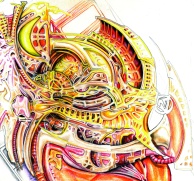Predgovor prvom ciklusu...
Odnos čovjeka i stroja od samoga početka nije sretan. Humano u srazu s artificjelnim uvijek doživljava poraz. Možda jednom u alternativi budućnosti stvari i neće izgledati tako no o tome neka pišu drugi.
Upravo u gornjem pasusu idejno bi se mogao sublimirati stripovsko opredjeljenje Marija Sokoliæa. Moć anticipiranja kataklizme uvijek je bila primamljiva za likovne umjetnike te tako ni Sokolić nije odolio. Forma stripa očito odgovara autoru i zbog dobne granice a dinamika priče u stripu se najjasnije očitava kroz njegovu “kvadrotovsku” strukturu gdje se dinamičko-crtački senzibilitet Sokolićeve provenijencije snalazi poput ribe u vodi.
Sokolić gradi nehumani svijet budućnosti očito kao upozorenje nama danas. Ova didaktička pretpostavka bila bi dovoljna za odvijanje same stvari no uronivši u strukturu crtačke magije ne možemo ne posumnjati u autorovu iskrenost.
Minuciozni svijet strojeva daleke ali ipak izgledne buduænosti ne služi samo čovjeku, nego ga svojom sofisticiranom strukturom uništava. Čovjek posjeduje autonomnost djelovanja, ukoliko to dobiva stroj, što se onda dešava?
Na ovo pitanje Sokoliæ daje nedvosmislen odgovor. Poraz humanog vidljiv je već danas, jer ako jednom zaista dođemo u priču kraj je vrlo izvjestan. Priličan broj ilustracija tematski se nadovezuju na sam strip a dihotomija čovjeka i stroja snažno je naglašena.
Osjećaj za detalj doveden je do gornje granice perceptivnosti, dok je kompozicijski naglasak na simetriji. Olovka je i dalje najjače Sokolićevo oružje te bi se nje trebao i držati.
U svakom slučaju ovaj dio radova daljnji je pomak u Sokolićevom profesionalnom radu te u tom kontekstu treba očekivati daljnje rezultate.
Todorowsky 2000.
The relationship between a man and a machine from the very beginning has not been a happy one. The human is always defeated in the collision with the artificial. Maybe once, in a future alternative things will not appear like that, but let the others write about it.
The above fragment could ideologically sublimate the cartoon orientation of Mario Sokolić. The power of anticipating a disaster has always attracted artists and Sokolić couldn’t resist it either. The cartoon form obviously suits the author because of his age. The dynamics of the story in cartoons is most evident in his “square” structure, where the dynamic drawing sensitivity, typical of his orientation, finds its way “like a fish in the water”.
Sokolić builds an inhuman future world apparently as a warning to all of us today. This didactic supposition would be enough to enable the things going but plunging deeper into the structural magic of his drawing, we cannot have doubts about the author’s sincerity.
The meticulous world of machines of the distant, yet possible future, is not only useful to a man, it also destroys him with its sophisticated structure. A man is autonomous in his action, but what happens when a machine becomes autonomous?
Sokolić gives an unambiguous answer to this question. The defeat of the humane is already visible, because if we once come into the story, the end is very certain. A considerable number of illustrations is a thematic continuation of the cartoon. The dichotomy between a man and a machine is strongly stressed.
The feeling for detail has been brought to the upper limit of perception, whereas the compositional accent has been put on the proportion. Pencil is still his strongest means and he should continue to use it in his work.
Anyway, this part of his work is a further step ahead in the Sokolić professional work and in this context we expect further results.
Todorowsky 2000.
